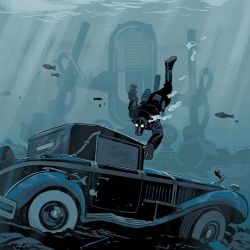As we close out Dark Horse Month here at Multiversity, I thought it would be fun to chat with two of the men who have been with the company since the beginning. If Daniel Chabon is on one end of the seniority spectrum of Dark Horse editors, these two gentlemen are at the other. As you’ll read below, the only person who’s been with the company longer than Randy Stradley and Chris Warner is publisher Mike Richardson! Trying to even sum up their editorial credits (without adding in Warner’s art credits) at the company would take us halfway to a ‘Dark Horse at 40’ celebration, but suffice it to say that if it has the Dark Horse logo on it, betting that either of these men was involved would be a pretty safe bet.
The first issue of “Dark Horse Presents”, kicking off Dark Horse Comics, had contributions from both of you. How did you end up being part of that comic?
Randy Stradley: Mike Richardson had already brought me on as editor, and we were tapping our friends from APA-Five.
An aside is probably due here to explain that an APA is an Amateur Press Alliance — essentially a group of like-minded fans, each of whom published their own zines and shared them with the other members of the group. In addition to producing their own work, most members also commented on the work done by the other members. Kind of a mutual support group for fans and would-be creators.
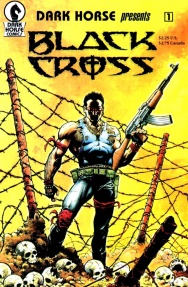
Mark Verheiden started APA-Five during his misspent youth, and I believe it is still going to this day (though with an entirely new roster of members). Among the former members were the aforementioned Mark Verheiden, Chris Warner, Paul Chadwick, Frank Miller, Ron Harris, Mark Badger, Mike Richardson, Randy Emberlin, and myself.
Anyway, we had already enlisted Chris Warner and Paul Chadwick, and Randy Emberlin mentioned he’d like a writer to collaborate on an idea he had called Mindwalk. So, to get to the answer of your question, I guess I kinda hired myself (with Mike’s approval, of course).
Chris Warner: Also, to give the devil his due, prior to my working for Marvel, Mike Richardson showed some of my APA-5 art to Luke McDonnell, who was drawing Iron Man at the time, and Luke offered to show samples to Marvel editors if I worked something up. I did, and Luke got some feedback to me and suggested I work on some new stuff and attend the San Diego Comic-Con that summer. I did, and got a nibble from Carl Potts at Marvel, which gave me the gumption to move with Randy to New Jersey to seek steady work in comics, which happened the next year. Long story short, Mike had a part in getting my first break, so the least I could do was to answer the call when he invited me to contribute to Dark Horse Presents, a decision I deeply regret every time Mike retells the story of “Dark Horse Presents” #1, which is pretty much every time I see him.
Randy, I don’t see much in the way of creative credits for you pre-“Dark Horse Presents”. Were you part of the Dark Horse crowd before the anthology was planned?
RS: After getting my foot in the door with a few stories published at both Marvel and DC, I ended up in Los Angeles working in the classifieds department (along with my pal Mark Verheiden), while still fishing for more freelance work. That’s where I was when Mike Richardson called me and told me he was ready to embark on his long-time dream of starting a publishing company. He asked me if I wanted to be the editor, and I said yes
I know you’d just come off a stint working for Marvel on “Moon Knight” & “Doctor Strange”; what made you jump into indie comics?
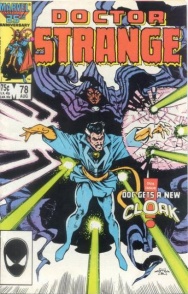
“Dark Horse Presents” looks like, in retrospect, the template for Dark Horse’s publishing success over the years: strong creator-owned involvement mixed with trying different genres & incorporating licensed properties in a seamless way. When did you get the sense that “Dark Horse Presents” had found a steady audience, and what did that response do to your publishing plans for Dark Horse moving forward?
RS: To be clear, Dark Horse offered creator ownership from the beginning because it was obvious that publishing companies automatically owning writers’ and/or artists’ creations was unfair. Not only was offering creators the rights to their own work the right thing to do, but it made good business sense — we were able to attract creators who probably would never have considered working with a fledgling company like Dark Horse.
We found an audience for “Dark Horse Presents” right from the beginning. If you were reading comics in the mid-1980s you’ll remember that there seemed to be a hunger for new material, new ways of approaching comics and storytelling. For a few years there, a sizable audience was interested in the comics medium — how it was being used and how boundaries were being pushed. Because of this, the story mix in “Dark Horse Presents” came about organically. I was trying to give the audience an interesting variety by pairing mainstream stories with more personal visions, and even the occasional “out there” story.
Dark Horse has been the first company people think of for licensed comics done ‘right’. Your 20th Century Fox properties have been a staple for the company and hit some real high marks over the years. How difficult was it setting up that relationship back in the 80’s and keeping both sides happy over the years? And was having a licensed comics presence at Dark Horse (be it Fox or Lucasfilm or Godzilla or Buffy) always part of the publishing plan?
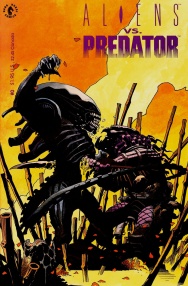
So, I bugged Mike to pursue Godzilla (granted, I didn’t have to bug him too much). He and I went and saw Aliens (and later Predator) and knew there were good comics to be made from them. Most movie-based comics were until that point pretty awful. I even heard one Marvel editor refer to them as “dog food books” — by which I assumed he meant they were a product not actually meant for human consumption. But we knew they didn’t have to be that way. We tried to find creators who were excited by the characters and the property, and let them pursue that excitement.
When we approached 20th Century Fox about Aliens, the studio’s licensing department consisted of exactly two people. That made working out deals and getting material approved for publication easy. Of course, that didn’t last. A licensing goldmine called The Simpsons came along, and by the early 1990s Fox’s licensing department had expanded from a small office on the main lot to an entire floor at Fox Plaza (“Nakatomi Plaza” from Die Hard). We’ve maintained good relationships with Fox all these years, so deals and approvals are still processed smoothly, but it will never be like it was at the beginning.
CW: We just wanted to do cool comics that we would want to read, and we didn’t care where they came from: creators, movies, our own ideas, whatever. Deals with licensors in the 1980s were less formal than today, before comic-book movies became mass-entertainment franchise engines. Back in the day, the licensors seemed surprised and happy that anyone wanted to do comics for properties that weren’t in theaters anymore — this was a time when the internet was more of a novelty for the tech crowd, and even home video was not ubiquitous, so keeping an audience interested in a property after the film had left theaters was difficult. Mike Richardson always tells the story that we pitched the idea of Aliens vs. Predator in a phone call, and our licensing contact at Fox said, “Oh, like King Kong versus Godzilla. Let’s do it!” Comics began to fill the spaces between films and keep fan interest in the properties. Comics became a key component in turning movies into franchises.
Continued belowDo you see comics helping movies become franchises as a good thing or bad?
CW: It’s a good thing, but I don’t really think about media franchise considerations much when making comics. I try to stay focused on how I can help make the comics better. While it can be fun to help flesh out the mythos of a popular franchise, the media stuff is so ephemeral that I feel I’m better off not burning too much fuel thinking about that stuff. I just try to lock in on the work and try to ensure we’re making good stories rather than trying to plug timeline holes or get the chance to finally give center stage to that obscure character who had two minutes on screen thirty years ago.
RS: Everything is good in moderation. Whether films are feeding off of comics, or comics are drawing on films, as long as that’s not the ONLY thing that’s going on, it’ll be fine. It’s a natural kind of synergy that benefits both mediums.
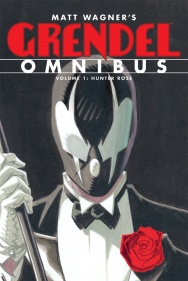
CW: I don’t think I’ve had a “rescue” project, but I don’t see any of these as rescues—the creators of those books had plenty of options. The creators brought their books to Dark Horse because they felt it was in their best interest to do so. And we just want to publish great stories. If they’ve been published elsewhere, no problem.
RS: There are always the “ones that got away” —- the projects or creators that I wish Dark Horse had published. Unfortunately, I can’t think of any right now (I’m at the tail end of a busy day). What does come to mind are a handful of projects I really wanted to do, only to have them slip away … and come to nothing —- either never get completed, or to turn out far differently than what you had expected.
That doesn’t mean Dark Horse didn’t have homegrown properties. Even though Comics Greatest World came out around the same time it seemed everyone else was debuting their own superhero universe, it had been in the works for a while behind-the-scenes. What made CGW an idea the company felt worth pursuing, and do you think it’s gotten it’s due in the years since?
CW: Dark Horse always wanted to do superhero books, and still does. The time seemed ripe for us when we moved ahead with CGW, and it’s release was very successful, both financially and creatively, but the market couldn’t sustain the flood of superhero titles that hit in the early 1990s. CGW’s “due” is an irrelevancy, frankly. CGW had its time and gave its best shot. We’re proud of the work, but we’re keeping our eyes on the next thirty years!
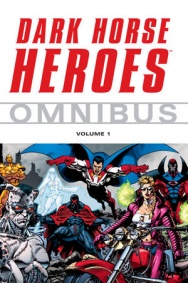
Until we embarked on the CGW stories, I hadn’t really given superheroes much thought. I’d thought I was done with them. But once we began creating the characters and building stories around them, I discovered they were a lot of fun. I also discovered how wonderfully convenient it was to have a character who could literally fly from location to location …
Continued belowJust an aside here: I had proposed the term “Comics’ Greatest World” as a tag line —- a play on Fantastic Four’s “World’s Greatest Comic” banner. Someone in our marketing department began using it as a handle for all we were building and it stuck.
As if you didn’t have enough legs on the Dark Horse table, the company has a history of putting out US releases of foreign work, both Japanese and European, stretching back to almost the beginning of the company. Since most fans my age or younger found out about titles like “Ghost In The Shell” or the entries in “Cheval Noir” from you, I’m curious how you found and decided which books to release?
RS: As I think either Chris or I mentioned elsewhere (and if we didn’t, shame on us), Dark Horse’s raison d’etre has always been to publish comics that we ourselves would want to read. No matter from what country they originate. Mike Richardson was the driving force behind “Cheval Noir”, having been a longtime fan of Moebius, Philippe Druillet, and many other European artists.
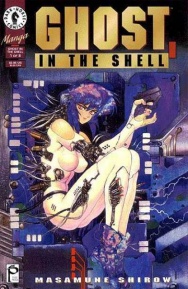
Earlier this month we published a look at some of the company crossovers Dark Horse has put out. I found out the Predator/Magnus was almost Terminator/Magnus, which was really interesting. Were there any other crossovers that you really wished would have happened but didn’t? And is there a particular reason why there’s never been any crossovers with Marvel’s characters?
RS: Who is this “Marvel” of which you speak?
If you’re asking me, it’d probably say there are crossovers that I wish hadn’t happened. But that’s me. Enough of a good thing is enough. Unless there’s something about the characters that screams for them to grind against one another, or there’s something in the story that allows the reader to move beyond the question of “who’s stronger” that is at the core of virtually every crossover, I’m not really interested. I get why people are, but I can only speak for myself. I will say that I thought Frank Miller’s device for getting RoboCop to the future so that he could fight the Terminators and Skynet was pretty brilliant.
CW: I’d like to see a Predator/Gilligan’s Island crossover. Think of the possibilities of the Professor getting ahold of Predator technology!






